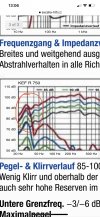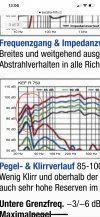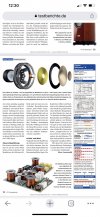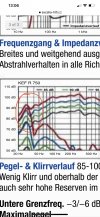But the graph from stereoplay I posted earlier shows clearly that it distorts in lower bass even without eq. Audibility is another thing. But then we were unnecessarily bashing the canton Speakers back then as their also on graph it’s there but when I demoed them I couldn’t hear anything whatsoever. Yet I agreed to you because I wasn’t sure what I heard was distortion or sound. Anyway it was harmonic that nothing stood out. Call me anything, but I say again, that canton had more stunning sound in general than the r11 I listened !! If a random person walks into a store and demo both, there is a huge chance that they would overlook the r11 as r11 compared to all speakers in the category appears dull immediately. And sounds more vocal heavy.I don't know
But even with DSP in my R7s they can go very very loud, bookshelf tend to have their 100% of distortion much earlier in sub bass
This is a comparason r7 vs r3, anechoic chamber, im not sure
at 86dB kef told me the intetion with the towers was lower the 20hz-200hz distortion, but also because towers have 2 ports you can add one port lower, this is clearly represent here:
View attachment 186627
The distortion start to rise at very super loud volume, If you wanna play super loud the R11 are going to perform better at super loud volumes, but if you wanna super loud volume it's better add 2 subs.. if not, then the R11. But you can add 2 subs into the R11 anyway, lol.
Towers can play very loud..
Having that much distortion at lower frequency's it's ok, most speakers don't do 20hz.. it's pretty normal have a high distortion in that region
Even References or that magico you posted have that kind of distortion, your R11 have 4 woofers, and apparently that help a lot more that a bit better woofer
I guess the R11 can go very loud and play everything with ease
View attachment 186628
View attachment 186630
One thing I don’t understand here is, why is the distortion graph of all speakera different from freq response ?






